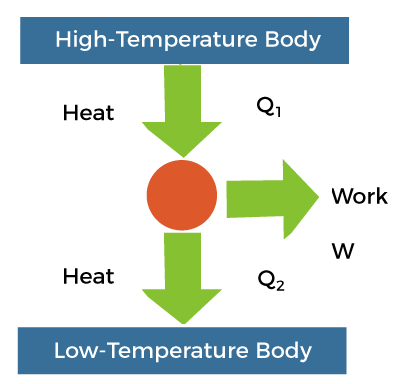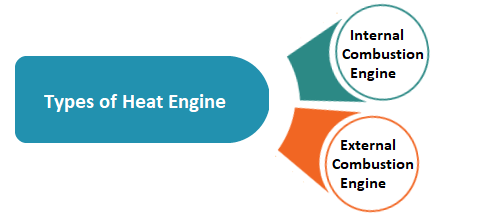Heat engineWe know that heat is a form of energy, and a system can be given energy either by providing heat or some mechanical work. An engine is a machine designed to convert one form of energy into another. Thus, a heat engine is an engine that takes some heat energy from the body at a higher temperature, converts a part of its energy into mechanical work, and delivers it to the body at a lower temperature. The diagram representing the basic activity of the heat engine is shown below: 
We can also say that the concept of the heat engine is based on the first law of thermodynamics. According to the law, a system can be given an amount of energy either through heat or some mechanical work. The main advantage of heat engines is that it can use various processes, such as consumption and friction to convert different forms of energy into heat energy. Here, we will discuss the efficiency of the heat engine, types of heat engines, and examples of heat engines. Efficiency of heat engineLet us suppose that the amount of heat from the high-temperature body be Q1, the work done by W, and the heat rejected by the system to the low-temperature body be Q2. The system observes no change if the system's final state is the same as its initial state. According to the first law of thermodynamics, we can write the equation as: W = Q1 - Q2 Efficiency = work done by the engine/heat supplied to it = W/Q1 = Q1 - Q2/Q1 = 1 - Q2/Q1 Let's now discuss the types and examples of heat engines. Types of Heat engine
The types of heat engine are classified as:
Let's discuss this in detail. Internal Combustion EngineCombustion refers to the burning of fuel. When the fuel burns inside a system, it is known as internal combustion engine. It commonly uses petrol or diesel as the heat energy source. The internal combustion engine produces the work by burning the fuel creating a high pressure environment. The produced work is further used to run a turbine/piston, which converts the heat energy from the fuel to the mechanical energy. The piston in the heat engines moves upward and downward, and a single movement of the piston in either direction is known as stroke. Most of the vehicles come in two stokes or 4 strokes, and the four strokes of two-wheelers or four-wheelers are named intake, compression, combustion, and exhaust stroke. The two common types of internal combustion engines are petrol engines and diesel engines. Advantages The advantages of an internal combustion engine are as follows:
Disadvantages The disadvantages of an internal combustion engine are as follows:
External Combustion EngineCombustion refers to the burning of the fuel. When the fuel burns outside a system, it is known as external combustion engine. The external combustion engine produces the work by burning the fuel, which is further transferred to the secondary liquid. Such working fluid is placed inside the system. Such fluid acts on the mechanism of the combustion engine and produces work. The fluid is not wasted after the use, but is recycled and reused. The heat source for both the external combustion engine and the internal combustion engine is combustion. A common example of the external combustion engine is the steam engine. Advantages The advantages of an external combustion engine are as follows:
Disadvantages The disadvantages of an external combustion engine are as follows:
Examples of Heat Engine
Let' discuss a small description about the above listed examples of the heat engine. Carnot EngineCarnot engine is a theoretical engine. The working of Carnot engine is based on the Carnot cycle, which comprises of four states. The states are named as Reversible isothermal expansion, Reversible adiabatic expansion, Reversible isothermal compression, and isentropic compression. These stages describe the processes of conversion of heat into work. Carnot also states that the engine requires a hot body, which acts as an energy source for the engine, and it transfers that energy to the cold body to do some mechanical work. The concept of heat transfer is based on the second law of thermodynamics. Steam EngineAs the name implies, the steam engine takes energy from the steam. Thus, the steam engine is a heat engine that takes heat from the steam (vapor form of a liquid) and converts a part of it into mechanical energy. The energy produced is used to move the piston, which is further used to run various objects, such as a train. The efficiency of steam engines ranges from about 3 % to 10 %, and it is less than other engines. But, steam turbines are widely used today to produce energy due to their high efficiency. Hence, the steam expansion in such turbines is continuous. Today, steam engines come in various types of designs, but the concept of producing energy remains the same. Evaporative heat enginesThe evaporative heat engine works at reduced pressure by evaporative cooling of dry air. Apart from producing power in hot arid climates, the evaporative heat engine can also be used as an evaporative cooler. It can also function well on industrial waste heat. The advantage of an evaporative heat engine is that it works best in hot, dry climates. Petrol enginePetrol engine is also known as the Otto engine because it was developed by Nicolaus August Otto, a German engineer. The mixture of petrol and air is inserted in the main cylinder, which is made of steel. In such engines, a spark plug is placed in the main cylinder and produces electric sparks, and these sparks burn the petrol-air mixture. Diesel engineThe diesel engine uses diesel as the fuel, and its construction and working are similar to that of a petrol engine. The fuel ignites easily due to high temperatures, and it results in the piston movement with a greater force. Thus, a large amount of mechanical energy is obtained. FAQsLet's discuss some frequently asked questions. Question 1: What is the recently environment friendly alternative initiated for the oils used in the heat engine? Solution: Batteries To save the usage of oil in various engines, batteries are recommended as an eco-friendly alternative. It also stores energy and act as a backup when there is no electricity. Question 2: Are heat engines 100 % efficient? Solution: No system is 100 % efficient. Due to some practical limitation, the efficiency of heat engines ranges between 30 and 50 %. Question 3: What is the main difference between heat and temperature? Solution: Temperature defines the average kinetic energy and is measured in Kelvin, Celsius, and Fahrenheit. Heat describes the transfer of thermal energy between molecules in a system, and heat also measures energy flow. Question 4: When does heat flows fastest? Solution: Heat flows fastest from the hotter substance to the cooler substance, and it means that the heat flows from a body at a higher temperature to the body at a lower temperature.
Next TopicBlackbody radiation
|
 For Videos Join Our Youtube Channel: Join Now
For Videos Join Our Youtube Channel: Join Now
Feedback
- Send your Feedback to [email protected]
Help Others, Please Share










